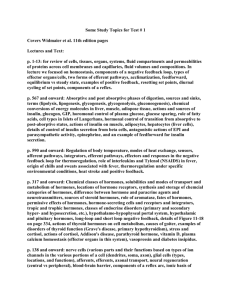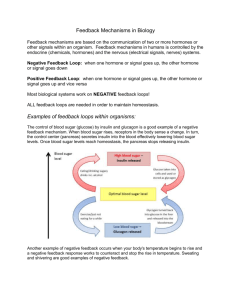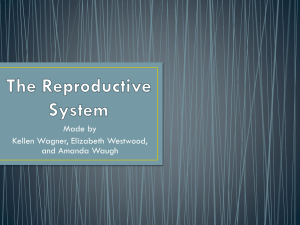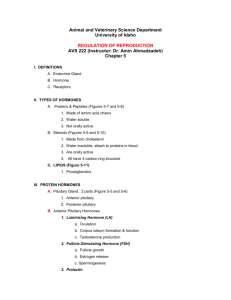Activity 45.1 How Do Hormones Regulate Cell Functions? This
advertisement
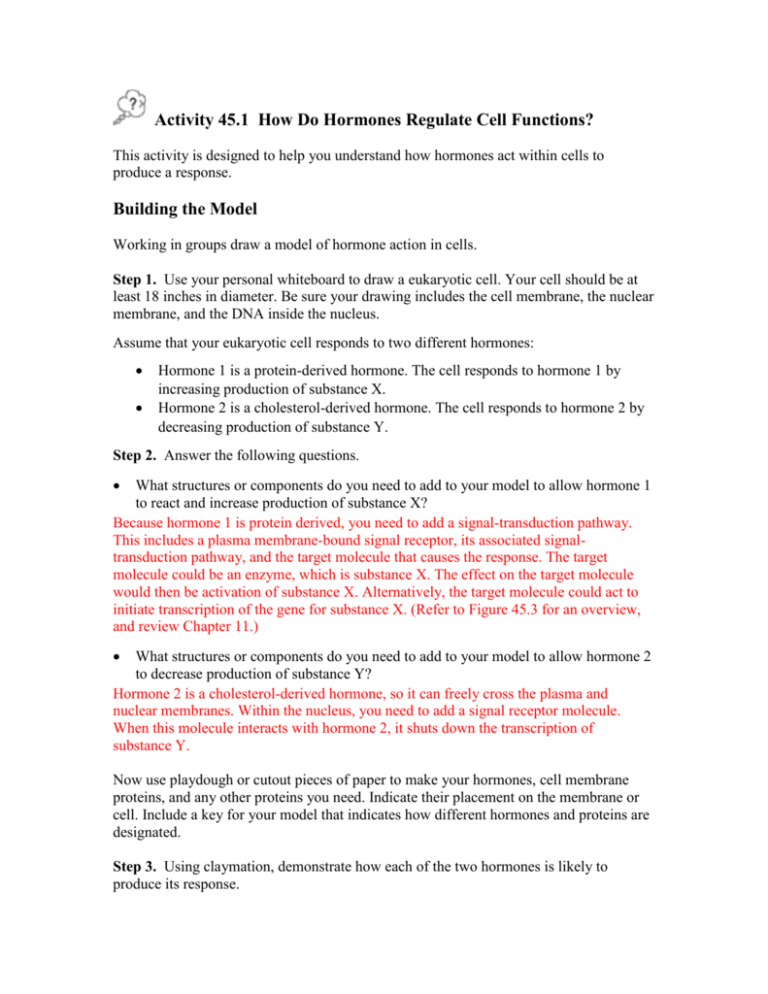
Activity 45.1 How Do Hormones Regulate Cell Functions? This activity is designed to help you understand how hormones act within cells to produce a response. Building the Model Working in groups draw a model of hormone action in cells. Step 1. Use your personal whiteboard to draw a eukaryotic cell. Your cell should be at least 18 inches in diameter. Be sure your drawing includes the cell membrane, the nuclear membrane, and the DNA inside the nucleus. Assume that your eukaryotic cell responds to two different hormones: Hormone 1 is a protein-derived hormone. The cell responds to hormone 1 by increasing production of substance X. Hormone 2 is a cholesterol-derived hormone. The cell responds to hormone 2 by decreasing production of substance Y. Step 2. Answer the following questions. What structures or components do you need to add to your model to allow hormone 1 to react and increase production of substance X? Because hormone 1 is protein derived, you need to add a signal-transduction pathway. This includes a plasma membrane-bound signal receptor, its associated signaltransduction pathway, and the target molecule that causes the response. The target molecule could be an enzyme, which is substance X. The effect on the target molecule would then be activation of substance X. Alternatively, the target molecule could act to initiate transcription of the gene for substance X. (Refer to Figure 45.3 for an overview, and review Chapter 11.) What structures or components do you need to add to your model to allow hormone 2 to decrease production of substance Y? Hormone 2 is a cholesterol-derived hormone, so it can freely cross the plasma and nuclear membranes. Within the nucleus, you need to add a signal receptor molecule. When this molecule interacts with hormone 2, it shuts down the transcription of substance Y. Now use playdough or cutout pieces of paper to make your hormones, cell membrane proteins, and any other proteins you need. Indicate their placement on the membrane or cell. Include a key for your model that indicates how different hormones and proteins are designated. Step 3. Using claymation, demonstrate how each of the two hormones is likely to produce its response. Use the understanding you gained from your model to answer the questions. 1. In medical applications, the type of hormone dictates the mode of administration— for example, oral versus injection, and so on. a. How would you need to administer hormone 1 to an organism deficient in this hormone? Because hormone 1 is protein derived, it is likely to be digested if taken orally. As a result, protein hormones—for example, insulin—must be administered by injection. b. How would you need to administer hormone 2? Cholesterol-derived hormones are generally not digested. If taken orally, they pass from the digestive tract into the lacteal system and move from there into the circulatory system. An example is birth control pills, which contain combinations of progestin and estradiol. 2. Hormones often act in an antagonistic fashion. That is, one hormone will initiate a certain response while another inhibits that response. Illustrate this process using insulin and glucagon as examples of antagonistic hormones. Insulin and glucagon act to regulate blood sugar concentrations within a fairly narrow range. Increases in blood sugar concentration—for example, after a meal—stimulate the beta cells of the pancreas to secrete insulin. Insulin triggers the cells of the liver and body to take up more glucose and store it as glycogen. Both the blood sugar level and the release of insulin drop. Low blood sugar levels cause the alpha cells of the pancreas to respond by releasing glucagon into the blood. Glucagon triggers the liver to break down glycogen and release glucose into the blood. (See also Figure 45.12.) 3. Assume you are trying to characterize one of the hormones that is involved in the neuroendocrine regulation of milk production. You make extracts of blood and mammary tissues of normal, lactating (milk-producing) animals and assay these extracts by injecting them into animals (whose hypothalamus has been surgically removed) and looking for restoration of milk production. Indicate whether each of the following findings is consistent with the hormone being a steroid, a peptide, or either type. a. It is found in blood. Either type is found in the blood. b. It is found in the cytoplasm of mammary tissue cells. Only steroid-type hormones are able to cross the cell membrane. c. It is found associated with receptors. Both types associate with receptors to produce a response. The difference lies in the location of the receptors. d. It is found associated with protein complexes that contain G protein. Only peptide or protein hormones associate with G protein complexes. e. It is found in nuclear extracts of cells. Only steroid hormonesare able to enter the cell and the nucleus.


